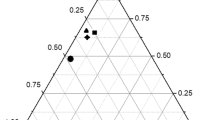Abstract
Three segmented polyurethane block copolymers PU-M, PU-X and PU-T containing different diisocynates, diphenylmethane-4,4'-diisocyanate (MDI), xylene diisocyanate (XDI) and 2,4-toluene diisocyanate (TDI) respectively with the same chain extender 1,4-butanediol (BD) and soft segment polyester-diol were investigated by small-angle X-ray scattering (SAXS). Microphase separation transition (MST) occurred due to the thermodynamic incompatibility between the soft and hard segments. The long domain spacing, interfacial thickness (or transition layer thickness), core zone, and lamellar thickness were determined for these three different polyurethanes from one dimension correlation function after the Fourier transformation of small-angle X-ray scattered intensity curve based on the Strobl and Schneider model. The structural parameters for these three polyurethanes determined from the scattering measurements indicate that the degrees of microphase separation are in the following sequence: PU-M > PU-X > PU-T.
Similar content being viewed by others
References
O. Glatter and O. Kratky,Small-Angle X-ray Scattering, Academic Press, London, 1982.
L. A. Feigin and D. I. Svergun,Structure Analysis by Small-Angle X-Ray and Neutron Scattering, Plenum Press, New York, 1987.
A. Guinier and A. Fournet,Small-Angle Scattering of X-Rays, Wiley, New York, 1955.
J. A. Miller, S. B. Lin, K. K. S. Hwang, K. S. Wu, P.E. Gibson and S. L. Cooper,Macromolecules,18, 32 (1985).
J. T. Koberstein and T. P. Russell,Macromolecules,19, 714 (1986)
Y. Li, T. Gao, J. Liu, K. Linliu, C. R. Desper and B. Chu,Macromolecules,25, 7365 (1992).
D. Tyagi, J. E. McGrath and G. L. Wilkes,Polym. Eng Sci.,26, 1371 (1986).
P. E. Gibson, M. A. Vallence and S L. Cooper,Development in Block Copolymers, I. Goodman Ed., Applied Science Series, Elsevier, London, 1982.
S. L. Cooper and A. V. Tobolsky,J. Appl. Polym. Sci.,10, 1837 (1966).
L. M. Leung and J. T. Koberstein,Macromolecules,19, 706 (1986).
R. W. Seymour and G. L. Wilkes,J. Polym. Sci., Polym. Lett. Ed.,11, 807 (1973).
R. Bonart,Polymer,20, 1389 (1979).
A. Noshay and J. E. McGrath,Block Copolymers: Overview and Critical Survey, Academic Press, New York, 1977.
W. Bras, G. E. Derbyshire, D. Bogg, J. Cooke, M. J. Elwell, B. U. Komanschek, S. Naylor and A. J. Ryan,Science,267, 996 (1995).
S. Etienne, G. Vigier, L. Cuve and J. P. Pascault,Polymer,35, 2737 (1994).
H. Tao, C. F. Fan, W. J. MacKnight and S. L. Hsu,Macromolecules,27, 1720 (1994).
A. J. Ryan, W. R. Willkomm, T. B. Bergstrom, C. W. Macosko, J. T. Koberstein C. C. Yu and T. P. Russell,Macromolecules,24, 2883 (1991).
B. Chu, T. Gao, Y. Li, J. Wang, C. R. Desper and C. A. Byrne,Macromolecules,25, 5724 (1992).
L. Cuve, J. P. Pascault, G. Boiteux and G. Seytre,Polymer,32, 343 (1991).
S. Etienne,Mechanical Spectroscopy in Materials Science, L. Magalas Ed., Elsevier, Amsterdam, 1994.
M. J. Elwell, S. Mortimer and A. J. Ryan,Macromolecules,27, 5428 (1994).
Y. Li, T. Gao and B. Chu,Macromolecules,25, 1737 (1992).
M. J. A. Elwell, A. J. Ryan, H. J. M. Grunbauer, H. C. Van Lieshout and J. A. Thoen,Prog RubberPlast. Technol.,9, 120 (1993).
G. R. Strobl and M. Schneider,J. Polym. Sci. Polym. Phys.,18, 1343 (1980).
F. S. Bates and G. H. Fredrickson,Ann. Rev. Phvs. Chem.,41, 525 (1990).
G. H. Fredrickson and K. Binder,J. Chem. Phys.,91, 7265 (1989).
G. C. Vonk and G. Kortleve,Kolloid-Z. Z. Polym.,220, 19 (1967).
L. E. Alexander,X-ray Diffraction Methods in Polymer Science, Wiley-Interscience, New York, 1969, Chap. 5.
E. W. Ficher, H. Goddar and G. F. Schmidt,Makromol. Chem.,118, 144 (1968).
B. Crist and N. Morosoff,J. Polym. Sci. Polym. Phys. Ed.,11, 1023 (1973).
P. Debye, A. M. Bueche,J. Appl. Phys.,20, 518 (1949).
L. Kahovec, G. Porod and H. Ruck,Kolloid-Z. Z. Polym.,133, 16 (1953).
O. Kratky,Pure Appl. Chem.,12, 483 (1966).
G. Porod,Kolloid-Z. Z. Polym.,124, 83 (1951).
W. Ruland,J. Appl. Crystallogr,4, 70 (1971).
Author information
Authors and Affiliations
Rights and permissions
About this article
Cite this article
Linliu, K., Chen, SA., Yu, T.L. et al. A small-angle X-ray scattering study of microphase separation transition of polyurethanes: Effect of hard segments. J Polym Res 2, 63–70 (1995). https://doi.org/10.1007/BF01493435
Issue Date:
DOI: https://doi.org/10.1007/BF01493435




